
The Book of Changes and Bagua Charms

The Book of Changes (I Ching, Yijing)
The I Ching expresses the core of ancient cosmic principles believed by the Chinese and also serves as a divination text. The basic principles underlying the I Ching are:
- Simplicity -- that fundamentally everything in the universe is, at its root, simple.
- Variability -- that everything in the universe is continually changing and one must therefore have an adaptable attitude toward life.
- Persistency -- that despite the universe being in constant change there is a persistent principle that is immune to time and space.
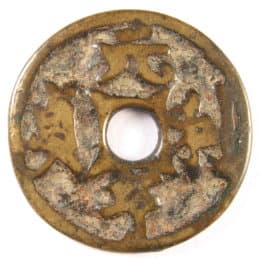
Whatever the true meaning, these first four characters of the I Ching were known by all educated Chinese.
The charm on the left has this famous inscription Yuan Heng Li Zhen (元 亨利贞) on its obverse and is read top to bottom and right to left.
This charm also has a special characteristic. It is unusual for a smaller coin-sized charm to have a round hole. Round holes are usually found on larger charms such as open work charms (please see Ancient Chinese Open-Work Charms).
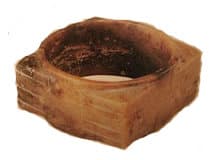
What is particularly intriguing about the round hole in this case is that it has a square border, with the four corners radiating outward, on both the obverse and reverse sides. Since ancient times the Chinese have represented the earth as square and the heavens as a circle. Pictured to the left is an example of a cong (琮) which is a neolithic jade object. The piece is square with a circular central hole and is very similar to the square with round hole of the charm. The cong is believed to be a ritualistic object representing the ancient Chinese belief that the sky is circular and the earth is square.
The Book of Changes (I Ching) is the ancient Chinese document describing the most basic cosmic principles and the cong is a powerful object, which even predates that document, and connects heaven, earth and man.
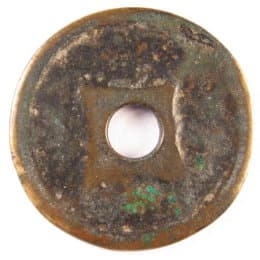
The reverse side of the charm has no inscription or pattern other than having the circular central hole with the radiating four corners of the square.
The charm is 29.4 mm in diameter and weighs 8.4 grams.
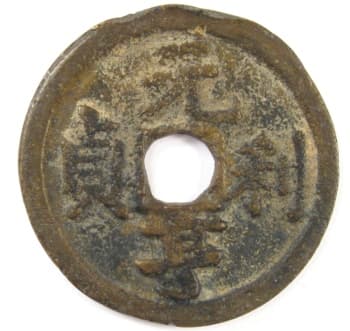
This is another old charm with the same obscure and mysterious, yet auspicious, four character inscription Yuan Heng Li Zhen (元 亨利贞) from the Book of Changes.
This is a larger charm. The diameter is 43.5 mm and the weight is 22.4 grams.
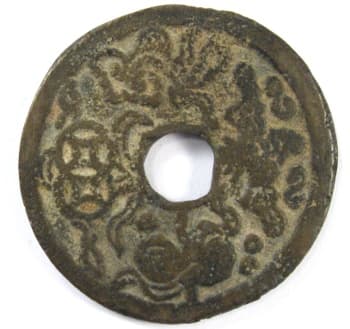
The reverse side of the charm displays an interesting combination of symbols.
At the top is a ruyi sceptre (ruyi 如意). The head of the sceptre is located at the eleven o'clock position with the handle curving down to the upper right corner of the center hole. There is a fillet or ribbon tied to the handle with the ends pointing to about the one o'clock position.
The head of the ruyi sceptre is shaped like that of the lingzhi or "fungus of immortality" and the lotus.
The ruyi sceptre is one of the "Eight Treasures" and is an ancient symbol of power and authority.
To the right of the square hole is a bat. The head of the bat is pointing toward the rim of the charm at the three o'clock position. The two wings are extended and the tail just touches the rim of the center hole.
At the bottom of the charm are two peaches tied together with a fillet or ribbon.
To the left of the center hole are two interlocking circles. Each of these circles represents a round Chinese cash coin with a square hole in the middle. The two "coins" are also tied together with a fillet or ribbon.
Such an incongruous collection of symbols actually makes sense as a visual pun or rebus.
The bat (fu 蝠) has the same pronunciation as the word for "good fortune" or happiness (fu 福). The peach (tao 桃) symbolizes "long life" and is carried by the God of Longevity (Shou Lao 寿老).
A pair of coins is pronounced shuang qian (双钱). But, an ancient word for coin is quan (泉) so the picture of the two coins can be interpreted as shuang quan (双泉) which has the same pronunciation as "both complete" (shuang quan 双 全).
Finally, the ruyi sceptre (ruyi 如意) shares the same pronunciation as the expression "according to your wishes" (ruyi 如意).
The combination of symbols, therefore, has the hidden meaning of "good fortune (happiness) and longevity both complete according to your wishes".
(For additional information on the peach "longevity" symbol please Chinese Peach Charms. The other symbols are discussed at Hidden Meaning of Chinese Charm Symbols.)
A basic concept of the I Ching is the "trigram". A trigram is a three-lined symbol. Each of the three lines in a trigram can either be continuous or broken. A straight line represents the yang (阳) and a broken line represents the yin (阴). Yin Yang (阴 阳) is the Chinese term for the basic polarities of the universe, e.g. male/female, light/dark, strong/weak, etc. There are eight possible combinations of these trigram components and these combinations are known as the eight trigrams or bagua (八卦).
The eight trigrams are used in both divination and feng shui (风水).
In olden times, people believed a bagua charm could repel "evil influences" and drive away "evil spirits". For this reason, it was not uncommon for a person to wear a bagua charm over their chest.
Families would frequently nail a bagua charm to the the roof beam of their house or to the top of a gate, and sailors would put one at a high point on their boat.
Several bagua or eight trigram charms may be seen below. Additionally, please visit Chinese Tokens to see an example of an old Chinese token coin displaying four trigrams.
While they did not appear on the ancient coins of imperial China, trigrams can be found on a few old Korean coins.
Bagua or Eight Trigram Charms
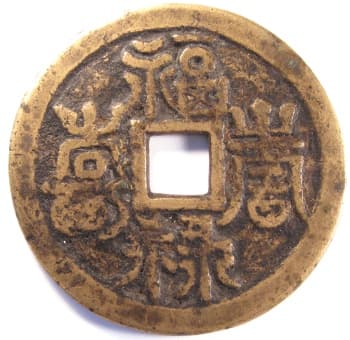
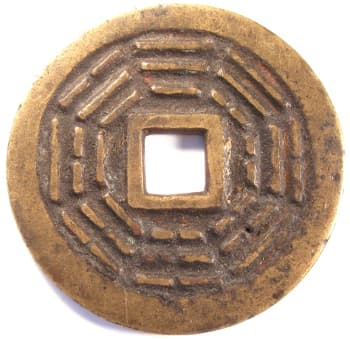
The old charm at the left is unusually large.
The inscription, written in a beautiful seal script, reads fu lu shou xi (福 禄寿喜) which translates as "Good fortune, official salary (emolument), longevity and happiness".
The reverse side is representative of this type of charm and displays the bagua (eight trigrams).
This large charm has a diameter of 57.3 mm and a weight of 45 grams.
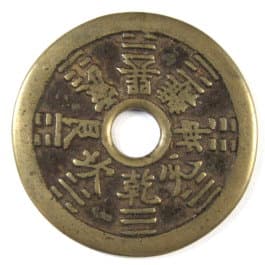
The charm on the left displays on its reverse the bagua (八卦) which are the eight combinations of trigrams.
The trigrams are related to the Five Elements (wu xing 五行) which is discussed in Ancient Chinese Charm Symbols: Star, Moon, Cloud and Dragon). The trigrams on this charm from the top and clockwise are as follows: xun 巽 (wind), li 离 (fire), kun 坤 (earth), dui 兑 (lake), qian 乾 (heaven), kan 坎 (water), gen 艮 (mountain), and zhen 震 (thunder).
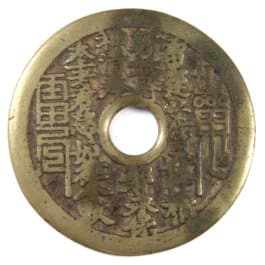
This is the obverse side of the charm. Its inscription and meaning is discussed in detail at Daoist (Taoist) Charms.
The diameter of this charm is 46 mm. The weight is 25.5 grams.
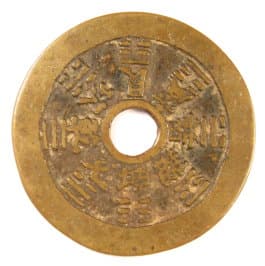
This is another example of a charm with the bagua or eight trigrams on its reverse side.
The diameter is 46 mm and the weight is 21.7 grams.
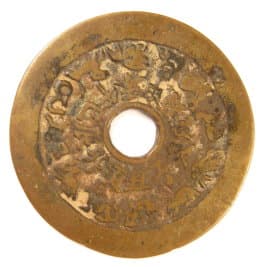
This is the obverse side of the charm showing the twelve animals representing the twelve Earthly Branches. For a further discussion of the twelve animals please see Ancient Chinese Zodiac Charms.
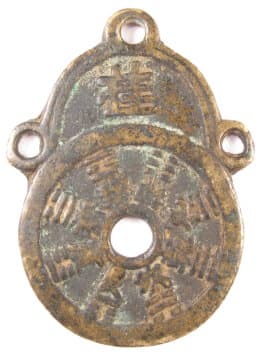
This is another specimen of a charm displaying the eight trigrams or bagua.
The canopy with the three loops indicates that it was meant to be worn. Usually these charms were worn around the neck as a necklace or attached to the waist. Sometimes they would be attached to rafters of houses or other structures.
To see additional examples of old charms meant to be worn or hung please visit Chinese Pendant Charms.
This charm measures 67 mm in length and 49 mm in width at its "ears".
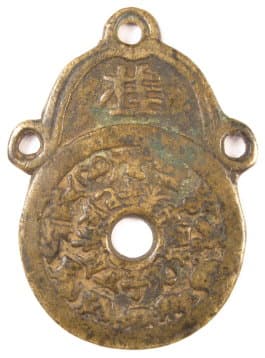
This is the other side of the charm. As with the previous example, this side shows the twelve animals representing the twelve Earthly Branches which I discuss in more detail in Ancient Chinese Zodiac Charms.
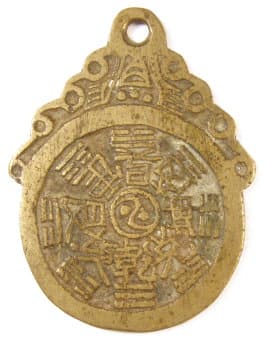
This is a final example of a Daoist charm with the eight trigrams or bagua. This charm also has the Yin Yang (阴阳) symbol at its center.
The charm measures 54.6 mm in length and 41.3 mm in width. The weight is 24.2 grams.
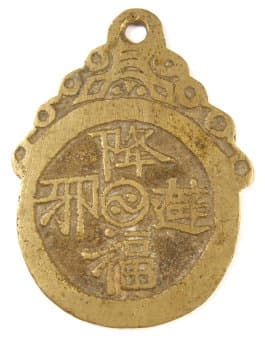
This is the obverse side of the charm. The inscription is read from top to bottom and right to left as jiang fu bi xie (降福避邪) which means "send down good fortune and keep away evil".
There is also a Yin Yang (阴阳) symbol at its center.
More examples of Taoist charms may be seen at Daoist (Taoist) Charms.
Return to Ancient Chinese Charms and Coins